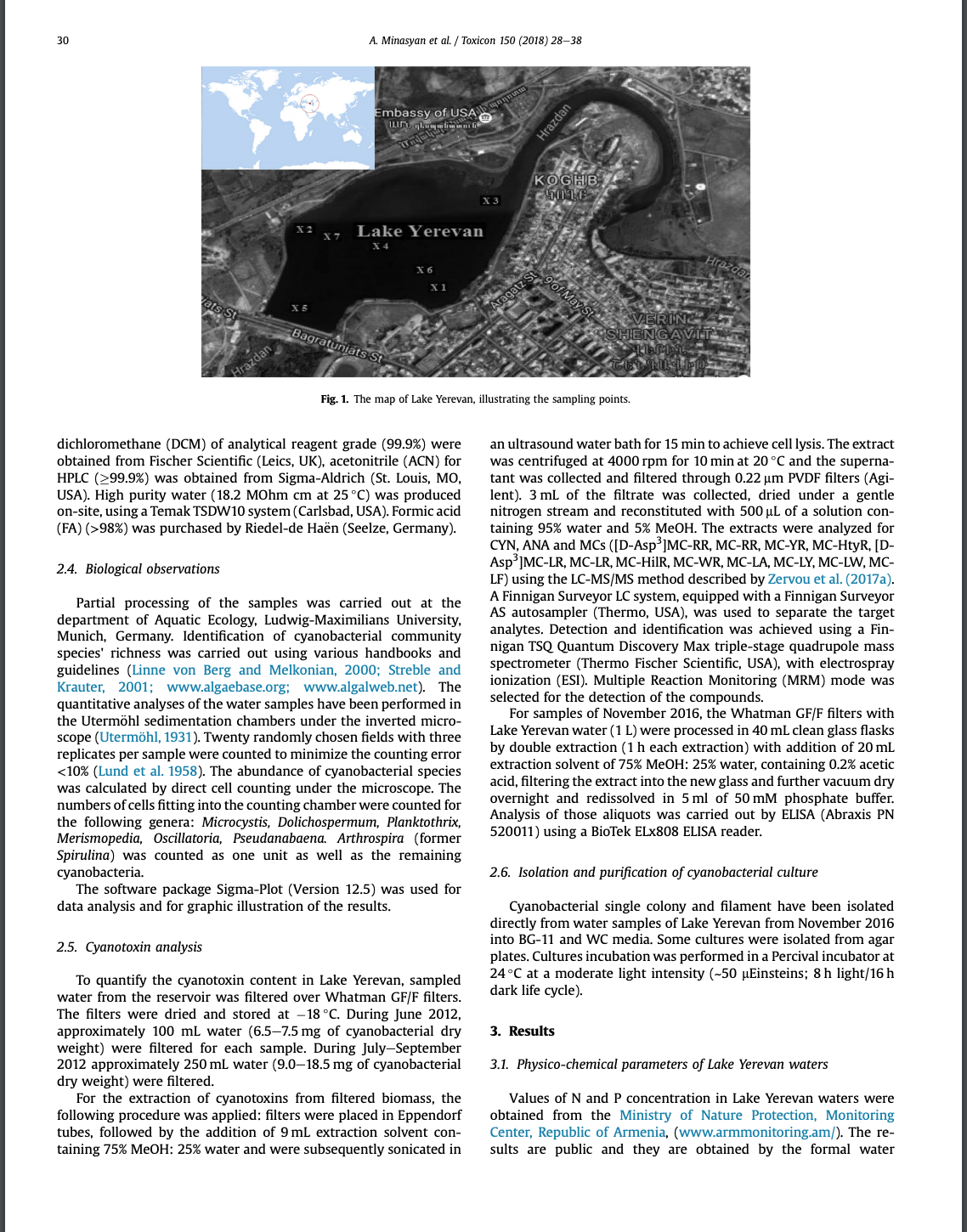Keyword: Microcystins

Minasyan, A., C. Christophoridis, A. E. Wilson, S.-K. Zervou, T. Kaloudis, and A. Hiskia. 2018. Diversity of cyanobacteria and the presence of cyanotoxins in the epilimnion of Lake Yerevan (Armenia). Toxicon 150:28-38.
Abstract
This paper presents the first report of cyanobacteria and cyanotoxins from the South Caucasus region, in particular from Lake Yerevan (Armenia). Microcystis, Dolichospermum and Planktothrix were the key genera identified during the growing season. A trend of a remarkable increase in cyanobacterial densities was observed from 2012 to 2013 exhibiting bloom formation in June (by Nostoc linckia) with the highest values in June and August 2013, reaching up to 695.9*103 cells mL−1. Seasonal dependence of cyanobacterial density on temperature, and temperature as a driver for cyanobacterial cells growth and development were suggested. Biogenic nutrients were identified as co-drivers determining species richness and dominance, as well as the distribution of phytoplankton in different parts of the reservoir. Cyanotoxin concentrations in the filtered biomass were reported during July 2012 for both stations of the reservoir (left and right bank). Microcystin-RR (MC-RR) was the most abundant and the most frequently observed cyanotoxin. Lower MC-LR concentrations were identified in all samples from both stations, with the highest values observed at the right bank in July 2012. [D-Asp3]MC-RR, MC-YR, MC-HtyR, [D-Asp3]MC-LR, MC-HilR, MC-WR, MC-LY and MC-LW were also identified in trace levels. Anatoxin-a (ANA) was reported in the samples from both stations during August 2012. Cylindrospermopsin (CYN) was present in trace concentrations in samples from both stations during July and in the sample from the left bank during September.
Kozlowsky-Suzuki, B., A. E. Wilson, and A. Ferrao-Filho. 2012. Biomagnification or biodilution of microcystins in aquatic foodwebs? Meta-analyses of laboratory and field studies. Harmful Algae 18:47-55
Abstract
Cyanobacteria, conspicuous photoprokaryotes in aquatic ecosystems, may produce secondary metabolites such as the hepatotoxins, microcystins (MC). While MC have been quantified in numerous aquatic consumers across a variety of ecosystems, there is still debate whether biomagnification or biodilution of MC generally occurs in aquatic foodwebs. Given the threat that MC pose to aquatic foodwebs, livestock, and humans, we synthesized data from 42 studies on the concentration of MC in consumers, such as zooplankton, decapods, molluscs, fishes, turtles and birds, to determine the dominant process. To compare results across studies, we calculated the biomagnification factor (BMF) as the ratio between the MC concentration measured in consumers and their diet. Biomagnification is indicated when BMF mean and associated 95% confidence intervals (CI) >1. Biodilution is shown if a BMF mean and 95% CI <1. As expected, increasing concentrations of MC in diets resulted in increasing concentrations of MC in consumers. Nevertheless, biodilution of MC was evident for most primary consumers. This finding was robust across four datasets that focused on different aspects of data independence and variance, and may be explained by low hydrophobicity of MC, diet preferences, or detoxification. Zooplankton and zooplanktivorous fish, however, showed some potential for biomagnification (i.e. mean BMF > 1). Plausible, but largely unexplored, possibilities for the relatively higher MC accumulation by these consumers are low detoxification efficiency by zooplankton, MC trophic transfer via the microbial foodweb, contamination of zooplankton net samples with large cyanobacterial colonies and filaments, or the release of both free and bound MC in zooplankton during digestion by fish. Factors related to study design may have influenced the magnitude of MC biodilution. For example, consumers fed diets consisting of highly toxic cyanobacterial lab cultures and large, potentially inedible net phytoplankton showed greater biodilution when compared to seston. Given their hepatotoxic nature, MC concentrations were relatively higher in liver and hepatopancreas tissues than other tissues. Whole organisms exhibited, however, relatively greater MC (i.e. higher BMF) than specific tissues, and this finding could be attributed to the contribution of zooplankton to whole organism MC analyses (89% of BMF estimates > 1). Finally, BMF was positively related to study length showing that longer exposure to toxic food resulted in higher MC accumulation in consumers, which could have important implications in eutrophic or tropical systems where toxic blooms may persist year-round.